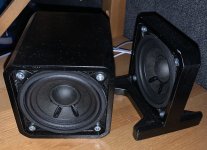Good point. Will try with foam board.I'm very excited that you are trying this out!
It might be worth experimenting with the angle of the drivers, as well as with some louvers (like the Metregon C45) to control at what angle you are starting to get a peekaboo listen of direct radiation from the driver.
I did not know that! Useful to know.Usually Dan, in my experience, much of the stereo ambience is actually between 250Hz and 1kHz.
So 2" drivers will not image as well alone as something a little larger, depending of course, on their frequency response capability.
The NS-2's should be ok to 250hz. I didn't want to go any bigger as it scales the whole design up considerably. They drop off at 200hz have 6mm xmax, so should be able to handle it. I have a 6" SB Acoustics mid-bass to drop into the back section to act as a sub.
I'll report back in a couple of weeks.
Frequency response aside there is directivity that is at play which is relative to size of things. I haven't thought about to what extent directivity plays role in this speaker concept but here is something to think about:
Small driver /structure radiates all around at 1kHz and below so it is basically mono system up to the enclosure size wavelenghts, except distance between drivers play a role as well as possible matrix used. Even though the drivers point to opposite directions, only frequencies that have shorter wavelenght than the transducer diameter "beam" to that direction, longer ones radiate all around. Frequencies that have smaller wavelenght than the baffle makes a shadow (to the back) as well creating some directivity.
Long story short the smaller the system the higher up everything radiates all around. 1kHz is 34cm long and to create any meaningful directivity the structure needs to be at least half of this. There is serious attenuation to back only when a driver beams.
I can't quite imagine right now how all this would play out, because sound panned center both drivers would play but panned somewhere else there might be negative polarity mixed in on the opposite side (if there is some matrix going on) in which case some kind of dipole system would form and give some attenuation towards the listener (straight ahead) etc, quite complex to imagine how it all comes together with distance between drivers, their directivities, matrix etc. Besides small direct radiator on a big baffle with hard edges is diffraction festival so it is not that simple 🙂
Simplified case would be: if single enclosure stereo speaker tries to output right panned sound to right wall with right pointed driver, it does so roughly on shorter wavelenghts (higher frequencies) than its size, be it a baffle, waveguide or array.
Small driver /structure radiates all around at 1kHz and below so it is basically mono system up to the enclosure size wavelenghts, except distance between drivers play a role as well as possible matrix used. Even though the drivers point to opposite directions, only frequencies that have shorter wavelenght than the transducer diameter "beam" to that direction, longer ones radiate all around. Frequencies that have smaller wavelenght than the baffle makes a shadow (to the back) as well creating some directivity.
Long story short the smaller the system the higher up everything radiates all around. 1kHz is 34cm long and to create any meaningful directivity the structure needs to be at least half of this. There is serious attenuation to back only when a driver beams.
I can't quite imagine right now how all this would play out, because sound panned center both drivers would play but panned somewhere else there might be negative polarity mixed in on the opposite side (if there is some matrix going on) in which case some kind of dipole system would form and give some attenuation towards the listener (straight ahead) etc, quite complex to imagine how it all comes together with distance between drivers, their directivities, matrix etc. Besides small direct radiator on a big baffle with hard edges is diffraction festival so it is not that simple 🙂
Simplified case would be: if single enclosure stereo speaker tries to output right panned sound to right wall with right pointed driver, it does so roughly on shorter wavelenghts (higher frequencies) than its size, be it a baffle, waveguide or array.
Last edited:
much of the stereo ambience is actually between 250Hz and 1kHz.
I'll go with that. I hear it centered around 400 Hz.

re-read the thread, I've missed a lot of posts, perhaps my previous post was unnecessary as everyone seems to be well on chart with directivity 🙂 well, hopefully there is some nugget for someone.
Thought about stereo separation on such system and the L and R single baffle dipole configuration seems quite good actually. There would be nice attenuation to front wall and to listener, and good directivity to low frequency down to sub even, but it would require multiway solution. If it was proper full bandwidth solution then perhaps a third channel is not even needed as in SSS? perhaps make monopole bass as third channel? making smallest possible structure to get directivity and cheap 2 or 2.1 class D amplifiers work fine since there is no matrix like in SSS. In addition there would be no ceiling or floorbounce if listening at the null.
I'm thinking just naked drivers/minimal baffle for the dipole part, perhaps a mid and tweeter of multiway dipole, for both sides L and R, could be just side by side on the same baffle making quite easy construction while all drivers would be on same plane creating a strong null. if listening straight ahead at that null one would hear just left and right wall reflection, full bandwidth. Is there dipole tweeters? Hmm, just two TC9 and a mono bass could work fine? Gotta try, need to build small bass box
Thought about stereo separation on such system and the L and R single baffle dipole configuration seems quite good actually. There would be nice attenuation to front wall and to listener, and good directivity to low frequency down to sub even, but it would require multiway solution. If it was proper full bandwidth solution then perhaps a third channel is not even needed as in SSS? perhaps make monopole bass as third channel? making smallest possible structure to get directivity and cheap 2 or 2.1 class D amplifiers work fine since there is no matrix like in SSS. In addition there would be no ceiling or floorbounce if listening at the null.
I'm thinking just naked drivers/minimal baffle for the dipole part, perhaps a mid and tweeter of multiway dipole, for both sides L and R, could be just side by side on the same baffle making quite easy construction while all drivers would be on same plane creating a strong null. if listening straight ahead at that null one would hear just left and right wall reflection, full bandwidth. Is there dipole tweeters? Hmm, just two TC9 and a mono bass could work fine? Gotta try, need to build small bass box
Last edited:
With two dipole the sound would cancel out all around with center panned sound wouldn't it? 😀 we'd need the center speaker and matrix, or perhaps toe in the dipoles some in order not to point the back of the other driver to cancel the front of the other and manage without the center.
I haven't read all the old threads on this but I suspect it is already tried by someone, perhaps in the 50s already 😀 anyway, single box stereo is fun concept to think about.
Anyway, we'd want to attenuate sound towards the listener because for example hard left panned sound, reflection from side wall comes late to the direct sound originating from the very same driver and perhaps there is now masking happening lessening perception to sound coming from the side. Beaming direct radiating driver or narrow directivity horn would also work but dipole seems more elegant solution, at least it would be smallest construct to get directivity below 1kHz, perhaps even full range. Perhaps fuzzines of small SSS versions stereo image is due to not enough wide band directivity, direct side sound is masking the reflected side sound smearing the image? Highs are hard panned and slowly collapsing into mono with all kinds of lobes due to sort of bipole or is it tripole configuration mixed in.
I haven't read all the old threads on this but I suspect it is already tried by someone, perhaps in the 50s already 😀 anyway, single box stereo is fun concept to think about.
Anyway, we'd want to attenuate sound towards the listener because for example hard left panned sound, reflection from side wall comes late to the direct sound originating from the very same driver and perhaps there is now masking happening lessening perception to sound coming from the side. Beaming direct radiating driver or narrow directivity horn would also work but dipole seems more elegant solution, at least it would be smallest construct to get directivity below 1kHz, perhaps even full range. Perhaps fuzzines of small SSS versions stereo image is due to not enough wide band directivity, direct side sound is masking the reflected side sound smearing the image? Highs are hard panned and slowly collapsing into mono with all kinds of lobes due to sort of bipole or is it tripole configuration mixed in.
Last edited:
tmuikku; great description of directivity. Thank you. However, I wasn't sure which idea you were addressing. Was it mine?
Yeah triggered by your post but perhaps it was more general since most SSS box photos on the forum use small full range drivers and are quite small which makes it common "issue" 🙂 Especially now since few people expressed importance of stereo quality below 1kHz and small monopoles just don't do it.
I'm not sure if it is readable between the lines of previous posts but the reasoning is that the side signal that ideally reach the ear through a wall reflection also comes directly from the speaker but as the driver(s) is pointed sideways toward the wall and beams on short wavelenght only we get low passed direct sound. With small driver we get direct sound quite high up in frequency, in case of 2" driver up to 5kHz perhaps, which arrives few ms earlier than the one through side wall.
If thinking only one side driver in isolation of a SSS system, you'd hear low frequencies first as direct sound and high frequencies through the wall reflection few milliseconds later, depending on the distance to the wall and frequency where the side driver is beaming. I don't know/remember how auditory masking exactly works but I would imagine a full bandwidth side panned sound signal from one speaker stereo box centered on a wall sounds like is spread from center to the side as frequency goes up because the system gets more directive. And not only that but also in time, highs delayed since they arrive to ear only through the wall reflection.
To cure this all we woukd probably need to make the side speaker narrow directivity so that less direct sound arrives before the side wall reflection. This means big beaming drivers or big horns, or just multiway dipole, which would make the smallest system physically being just the drivers.
I'm not sure if it is readable between the lines of previous posts but the reasoning is that the side signal that ideally reach the ear through a wall reflection also comes directly from the speaker but as the driver(s) is pointed sideways toward the wall and beams on short wavelenght only we get low passed direct sound. With small driver we get direct sound quite high up in frequency, in case of 2" driver up to 5kHz perhaps, which arrives few ms earlier than the one through side wall.
If thinking only one side driver in isolation of a SSS system, you'd hear low frequencies first as direct sound and high frequencies through the wall reflection few milliseconds later, depending on the distance to the wall and frequency where the side driver is beaming. I don't know/remember how auditory masking exactly works but I would imagine a full bandwidth side panned sound signal from one speaker stereo box centered on a wall sounds like is spread from center to the side as frequency goes up because the system gets more directive. And not only that but also in time, highs delayed since they arrive to ear only through the wall reflection.
To cure this all we woukd probably need to make the side speaker narrow directivity so that less direct sound arrives before the side wall reflection. This means big beaming drivers or big horns, or just multiway dipole, which would make the smallest system physically being just the drivers.
If there are two nude drivers on a baffle pointing to opposite sides, one is playing L, the other R, then I get L-R on one side and R-L on the other side up to a certain frequency, am I correct? Then, all what is needed is a center speaker (L+R). Maybe it would be worth experimenting with delay on the center. I have a small box with a 3FE22, I just need to cut a baffle for the 170 mm vintage drivers and do some experiments. Both in square and non square rooms. Again, another line on my project list.
Hmmmm...... I don't know. Would have to think about that. I do like the idea if it works.one is playing L, the other R, then I get L-R on one side and R-L on the other side up to a certain frequency, am I correct?

Yep, that should work!If there are two nude drivers on a baffle pointing to opposite sides, one is playing L, the other R, then I get L-R on one side and R-L on the other side up to a certain frequency, am I correct? Then, all what is needed is a center speaker (L+R). Maybe it would be worth experimenting with delay on the center. I have a small box with a 3FE22, I just need to cut a baffle for the 170 mm vintage drivers and do some experiments. Both in square and non square rooms. Again, another line on my project list.
It's pretty much the same as the outer four speakers of the six-speaker matrix, back on page 5 of this thread.
Using two speakers out of phase to produce a Difference signal is a bit imperfect though. If the speakers are above one another, they become highly reactive to what height you are listening at. Side-by-side was a bit better in my tests, but using 4, 6, or 8 speakers, alternating L and R, might blend (or rather, subtract) better.
This may not matter that much for the side facing signal, though, since that signal will be heard primarily as room reflections anyway.
For the front facing L+R Sum signal, using a pair of L/R drivers may not be as finicky, but using 4,6, or 8 speakers alternating (not sure what layout) might still work best.
Now I want to try this.
Or just make the L-R electronically and feed one OB driver/multiway side speaker with it? Perfect "summing" and great null towards listener, one amplifier channel.
If two drivers/sets of drivers was used in a mttm or wmttmw open baffle config would narrow vertical dispersion, have drivers pointing both ways, should be very much only shooting at the side walls fullrange, not much direct sound or to ceiling / floor.
The SSS approximates dipole as well with hard panned signal, although .5x the back signal would not make exactly perfect null but that is adjustable in the matrix isn't it, from .5 up to 1 which would be dipole with L-R? Anyway, fun concept to think about 🙂
Here is some ripple tank tests for fun, .5x and 1x SSS matrix with hard left panned sound.
The default .5x default matrix on first image makes beamsteering of sorts, more sound overall to left in relation to right (green probe). The dipole on second image is projecting as loud to both directions, the other is just polarity flipped. Much greater null though (red probe). This is ~1kHz size enclosure and drivers and ~1kHz sine, only the side drivers.
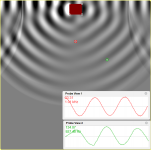
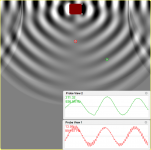
If two drivers/sets of drivers was used in a mttm or wmttmw open baffle config would narrow vertical dispersion, have drivers pointing both ways, should be very much only shooting at the side walls fullrange, not much direct sound or to ceiling / floor.
The SSS approximates dipole as well with hard panned signal, although .5x the back signal would not make exactly perfect null but that is adjustable in the matrix isn't it, from .5 up to 1 which would be dipole with L-R? Anyway, fun concept to think about 🙂
Here is some ripple tank tests for fun, .5x and 1x SSS matrix with hard left panned sound.
The default .5x default matrix on first image makes beamsteering of sorts, more sound overall to left in relation to right (green probe). The dipole on second image is projecting as loud to both directions, the other is just polarity flipped. Much greater null though (red probe). This is ~1kHz size enclosure and drivers and ~1kHz sine, only the side drivers.


Last edited:
Here is 300hz and 3kHz, the 0.5x matrix holds up the "pattern" on all of these I think, less sound to right, more to left.
I don't know how hearing system perceives all this, would .5x or 1x sound better. At least null towards listener (straight down from the box) would have wee bit greater null with the dipole, but it seems to be quite nice with the .5x as well.
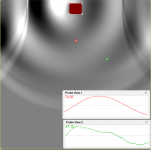
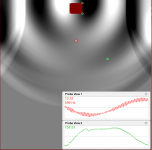
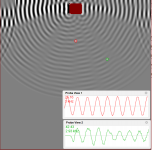
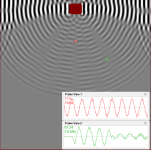
I don't know how hearing system perceives all this, would .5x or 1x sound better. At least null towards listener (straight down from the box) would have wee bit greater null with the dipole, but it seems to be quite nice with the .5x as well.




I could probably make you some M/S files if you want. I think that the latest JRiver will do it real time,My DSP cannot do it.
I am trying to install Linux and Pulse Audio Crossover Rack on a small PC. If I succeed, I can use that for real time playback. I used it some time ago for the SSS matrix, so I know it is possible. I think I could mix my own MS files as well, but I would like to be able to stream as I am used to. Too many projects running at the same time🙂
So, I've been mulling this over in relation to my build, just to see if theres anything I can do to improve before I put it together. In idiot terms, small driver on small baffle equals low directivity, which equals low desired stereo effect. My inward facing reflective arc/lens idea is not meant to be M/S matrix, just 2.1 standard. The drivers are not meant to "see" each other; the arc radius equals the depth of the baffle. Therefore if I increase the baffle/driver size the whole thing gets exponentially larger, which is pointless for the desired outcome (ie. might as well use two speaker boxes!). I've deliberately made it shallower in height, which unwittingly might have made the issue worse theoretically.Frequency response aside there is directivity that is at play which is relative to size of things. I haven't thought about to what extent directivity plays role in this speaker concept but here is something to think about:
Small driver /structure radiates all around at 1kHz and below so it is basically mono system up to the enclosure size wavelenghts, except distance between drivers play a role as well as possible matrix used. Even though the drivers point to opposite directions, only frequencies that have shorter wavelenght than the transducer diameter "beam" to that direction, longer ones radiate all around. Frequencies that have smaller wavelenght than the baffle makes a shadow (to the back) as well creating some directivity.
Long story short the smaller the system the higher up everything radiates all around. 1kHz is 34cm long and to create any meaningful directivity the structure needs to be at least half of this. There is serious attenuation to back only when a driver beams.
I can't quite imagine right now how all this would play out, because sound panned center both drivers would play but panned somewhere else there might be negative polarity mixed in on the opposite side (if there is some matrix going on) in which case some kind of dipole system would form and give some attenuation towards the listener (straight ahead) etc, quite complex to imagine how it all comes together with distance between drivers, their directivities, matrix etc. Besides small direct radiator on a big baffle with hard edges is diffraction festival so it is not that simple 🙂
Simplified case would be: if single enclosure stereo speaker tries to output right panned sound to right wall with right pointed driver, it does so roughly on shorter wavelenghts (higher frequencies) than its size, be it a baffle, waveguide or array.
Are there any dumb fixes (ie. recessing the baffles into the side enclosures slightly to make a crude waveguide/horn) (smaller 1" driver)? Or just give it a go as is?
I liked this idea as it reduces the reliance on the side walls, which (reference the first post) can often be irregular in real life. But I'm basing it from a model (the JBL Minigon) that was highly balanced and engineered and could fall apart with minor tweaks!!!
BTW does Pelanj have a telepathic 3D printer? ;-)
BBTW I'm a music producer and always use M/S recording on piano as it just sounds incredible.
I'm sure there are lots of VST/AU mid/side processing plugins out there that convert stereo to M/S for mixing and mastering. If you reverse the polarity on processed Side output to the speakers, it might work, but you need to check that as I'm not sure at all.I am trying to install Linux and Pulse Audio Crossover Rack on a small PC. If I succeed, I can use that for real time playback. I used it some time ago for the SSS matrix, so I know it is possible. I think I could mix my own MS files as well, but I would like to be able to stream as I am used to. Too many projects running at the same time🙂
eg; https://www.voxengo.com/product/msed/
- Home
- Loudspeakers
- Full Range
- Thoughts about single box stereo?
